This is an address I gave to the memorial service held for Malcolm at Oakwood
on Tuesday February 11, 2020
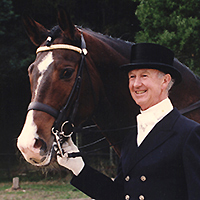
I’d like to talk about Malcolm and dressage. It seems to me that dressage has been for at least the last couple of hundred years, a battle ground, between the forces of darkness, the users – and abusers – of our friend the horse, and the forces of light, the horse people who work with the horse – delighting in his nature and seeking to unfold his brilliance through methods learnt from the horse himself.
Think of Baucher and Steinbrecht – one who set out to destroy the natural tendencies of the horse and create a man-made artificial creature to celebrate the rider not the horse – the other who set out to build a philosophy and a training scale the celebrated the horse and his natural beauty. A training program that still informs all civilised riding today…
Malcolm was always on the side of the angels in this dialectic. I suspect that long before he took ship to Germany, he had already grasped the fundamentals of the training scale simply because he was an animal person, an observer, a lover of the true nature of the animal, be it a horse or a dog.
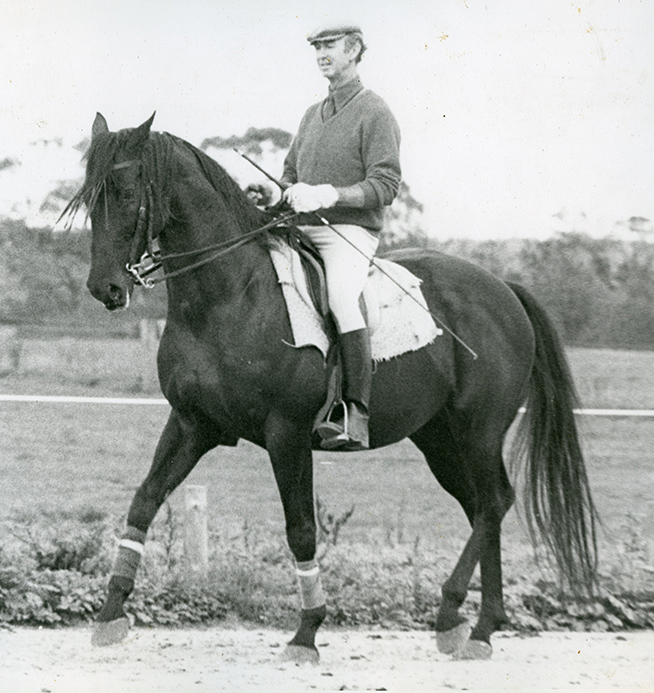
I also want to think about rhythm, it’s a key element in the training scale, but it is also a thread through Malcolm’s life. He first excelled in tennis, playing at a championship level, and then when asthma cut that short, turned to ballroom dancing, while secretly training a horse is defiance of his father’s strictures. Three sports / arts in which rhythm is an essential element…
And rhythm is a key player in the battle between lightness and the dark forces, the tense, jazzed up, ‘spectacular’ horses may be able to dazzle the ignorant, but one thing they cannot do is keep the natural purity of rhythm. And all of you who rode with Malcolm will remember just how crucial rhythm was in his lessons…
Malcolm was a natural. With his first top horse, Dorian, he won what was then the highest level of dressage, the Medium, three years running in the early1950’s while competing in A grade showjumping at the same time, on the same horse.
Another of Malcolm’s endearing traits was in evidence when he competed in those early dressage competitions – his flamboyance, and his love of dressing up. He was later to ride his Andalusian stallion, Horrie, side saddle and in drag, but one suspects in the fifties, it was enough to appear, as he did, on the main arena of the showgrounds advancing down the centre line in a scarlet hunting coat and a top hat he had bought from the funeral parlour.
Many years later, Oakwood ran fancy dress dinners in the indoor school where Malcolm appeared variously as an Airline Hostess, a Dustman and The Flasher!
But Malcolm was quite capable of mixing it with the best in the toughest of equestrian disciplines, three day eventing. In 1957, Malcolm brought Dorian out to win the Open Three Day event at Melbourne, second went to Bill Roycroft and Our Solo, third to Neale Lavis and Mirribooka, two combinations that went on to win the Eventing Gold medal in Rome in 1960.
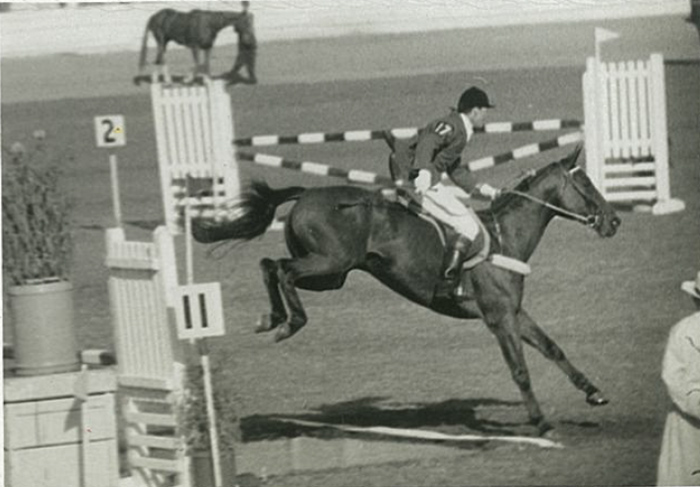
Malcolm riding Ever Ready at Sydney 3DE in 1959. They finished fifth behind Laurie Morgan’s two horses, and Bill Roycroft’s two.
However by 1960, Malcolm had sworn off jumping after three bad horse accidents, one broken fetlock, one broken hind leg, and one broken shoulder. For a while he contemplated giving up riding, then deciding instead to concentrate on dressage.
Malcolm taught at Oakwood Riding School from 1959 to 1962 – it was at Oakwood, that the German principles were first taught in Australia by the Cavalry officer, Antoine Nissen.
Malcolm then took the brave, almost unprecedented step, of traveling to Europe to further his knowledge of equitation.
Arriving in England, Malcolm watched Anneli Drumond Hay win the 1962 Badminton on Merely A Monarch. He then headed to Germany, to the National Equestrian Centre in Warendorf, where the German President, General Niemack told him there was nothing for him at Warendorf and that he would be better off back in England, where at Windsor, he watched the German riders, Reiner Klimke, Liselott Linsenhoff and Anneline Kuppers top the FEI classes. It was here that he met Bimbo Peilicke and Hans Becker who were later to give him a foothold in Germany.
After Windsor, Malcolm got a job at Fulmer. Malcolm – who had been taught in Australian by the Swiss immigrant, Joe Stadelmann as well as Nissen – was less than impressed with the manner and philosophy of the principal, Robert Hall, but got along well as the groom for Hall’s wife, Jook, who had been educated in her native Holland and at the Spanish Riding School. Mrs Hall was preparing to compete at Aachen and Hamburg shows with her Lipizzaner stallion, Conversano Caprice. Malcolm not only had to groom, but was left with her car to get the gear from Aachen to Hamburg, with no knowledge of either the language nor of driving on the right hand side of the road. Luckily for us all, he made it unscathed.
Back in England, Malcolm was paying five pounds and eight shillings a week for a room and earning five pounds a week wages. He started work at 7 am and finished at 6 pm, the bus fare was two shillings each way, so Malcolm did a lot of walking.
Malcolm traveled to Rotterdam where he again met up with Hans Becker, who suggested a place could be found for Malcolm in Germany. Malcolm was getting cold feet, how could he work anywhere where he did not speak the language?
To help him acclimatise, Becker took him to a riding school at Wülfrath where the leader was Herr Albert Brandl, who had won the Hamburg Dressage Derby at the age of 26, and at 27 was the chief instructor at Warendorf. Malcolm rode one of the school horses that was notorious for dumping the rider on the canter transition, without leaving the saddle, and was offered a job by Frau Brandl, who became a life long friend and mentor.
Before long, Malcolm was teaching all day and some of the night, riding several horses and working on his vocabulary as the examination with General Neimack, neared…
At the examination, he had to ride one horse in a snaffle and one in a double bridle and teach in German. He had to sit a written exam in German (the written part was translated by Frau Brandl). Malcolm came top, beating the Germans and all other nationalities. General Niemack actually congratulated Malcolm on his results. He received the Amateur Reitleher Certificate which allowed him to teach in Germany and he was at the riding school for 10 months.
Malcolm returned to Australia at the end of 1963 and commenced work at Oakwood Riding School. In 1966 Malcolm returned to Europe taking with him two horses, a Thoroughbred stallion Hawa Mahal (Aubrey) and Fanfare (Hoover), an Anglo-Arab by Riffal. The horses were loaded onto the ship in crates with ropes and a crane. The crane driver lost control of the crate that Hoover was in and it spun wildly. Hoover injured his hock and never competed again. Malcolm went back to Wülfrath.
In 1966 Malcolm’s mother and her sister travelled to England so Malcolm relocated with horses to Mill Hill, a riding school in the UK, and then to Suzanne’s Riding School. While working for Suzanne he taught seven hours a day and worked two horses, Aubry and a Russian mare, Brig. While there Malcolm sat the exam for BHS Assistant Instructor, which he passed, and a week later the exam for BHS Full Instructor, which he also passed.
Malcolm kept applying to Australia for a licence to compete in Europe but they did not answer his requests, however, he did compete Hawa Mahal at PSG level and came third. Disappointed he was not able to compete, Malcolm came home to Australia with Hawa Mahal. Malcolm worked his passage home. He was in charge of 13 horses, all stabled on the deck of the ship, with only a French-American boy to help. They had to water and feed all horse three times per day and muck out the stables. Four days into the trip, they were warned they were sailing into cyclones. The weather bureau directed them to go between two cyclones. There were chains between the horse boxes. The ship’s engines broke down in the middle of the storm and they were stranded for 36 hours before the engines started again. The crew told him that on the last trip five horses were washed overboard along with five men.
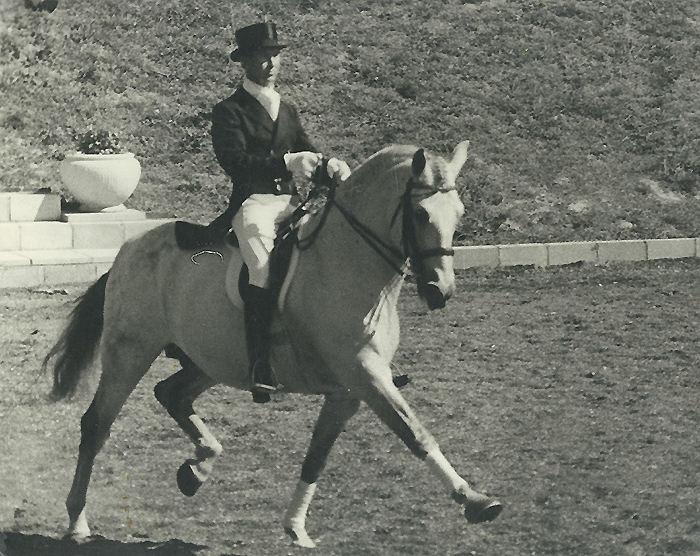
Malcolm and Hortelano
In 1975 Malcolm went to Spain with Alice Stainton with the view to buying Andalusian horses and another chapter in this extraordinary life was unfolding. Malcolm purchased Hortelano VII and Alice purchased Martinette, both stallions. Hortelano (Horrie) had been a bull fighting horse. Horrie sired many horses and competed very successfully up to Prix St Georges, winning many trophies. But the influence of Malcolm and Horrie was not so much in the competition arena but in the many demonstrations they gave.
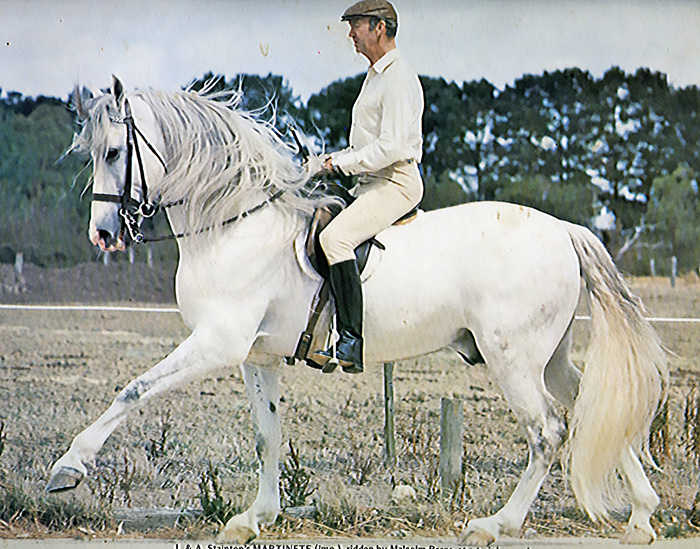
and Martinette…
Australia’s most decorated Olympic dressage representative Mary Hanna recalled after his death: “I remember watching him at Melbourne show on the two gorgeous grey Andalusians. He and Anna Aueur looked divine in capes when it was raining, both dressed beautifully. I thought they were so professional… and they were!”
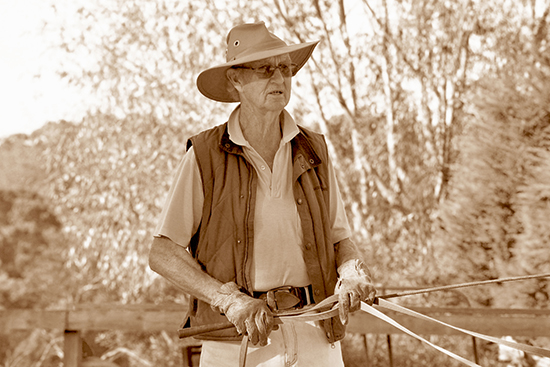
Lesley Ann Taylor was one of many Malcolm’s pupils who went on the Grand Prix, but her memory also reminds us of the other thread – Malcolm’s horsemanship:
“Many, many years ago when Malcolm was living at Strathalbyn I went to work with him as a working pupil. The first day he told me to help myself to anything in the fridge. As it was nudging 45 degrees that day I thought the bottle of cold beer would go down well. And it did. But there was a terrific row when Malcolm discovered the beer missing from the fridge, it was meant for the use on horses as a colic treatment…”
Malcolm’s riding lessons at Oakwood were amazing, ten, twelve riders, in a twenty by forty school and woe betide you if you did not keep the correct distance from the horse in front of you. And all the while, the emphasis was on rhythm, rhythm, rhythm, as Malcolm would count the beat as you rode. I can still hear him in my head, 1, 2, 3, 4 – one / two, one /two, ONE, two, three… and in the rest breaks, the pupils were cross examined on equitation theory, with Malcolm generously lending the classics from his own library.
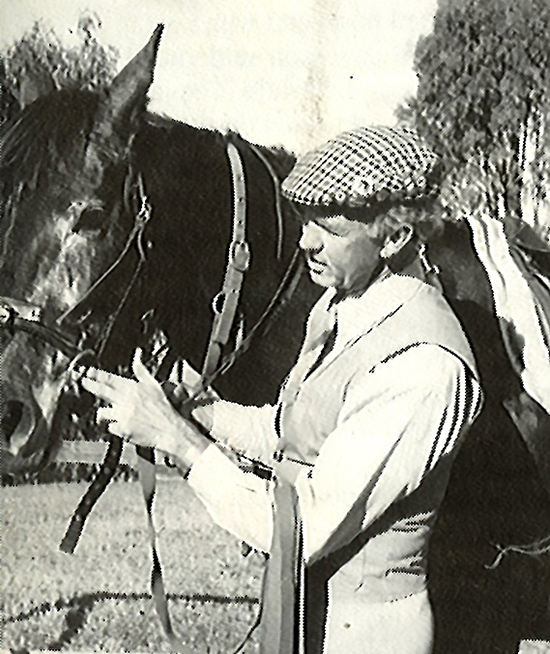
I am glad, and very sad, to now have that library in my possession, for turning to the classics, and the sentences underlined, here is Malcolm speaking to us again, reminding me of the other dimension I have not paid enough attention to, rider position. Sure enough, in his edition of Müseler’s Riding Logic, this sentence is underlined: “As soon as ‘balance’ is maintained fairly persistently it ought – and this is where the underline happens – be tested by doing away with the stirrups.”
I guess there are a few of us in this room who did not entirely enjoy Müseler’s advice at the time, but you could tell the successful graduates of the M Barns school, by their correct and elegant riding style.
Alas I feel I have only skimmed the surface of this extraordinary, charming, funny, warm and wise individual, that he touched so many can be seen here today, in his memory I would implore you to remember his teachings, to be with him on the side of lightness, of correct elegant riding, of relaxed and willing horses working in a natural rhythm. I am glad that Malcolm lived to see and enjoy the emergence of Carl Hester and Charlotte Dujardin on the world stage.
This was, and is, the dressage that Malcolm spent a lifetime demonstrating and teaching. How sad we are to see him go, how lucky we were to spend time with him. – CH
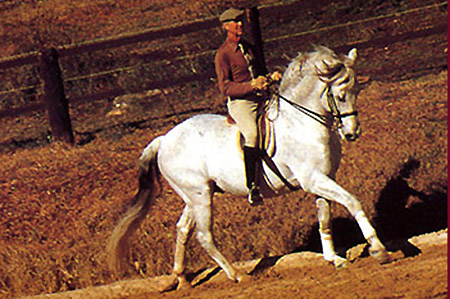



Wow, this was a fun article. I feel like I know this lovely man even though he’s no longer with us. Interesting that he’s not using a spur in even of those photos.
A question – what about Steinbrecht brings him into the same category as Baucher? I would love a followup on that.
I was contrasting the approach of Baucher wiith the horse friendly system of Steinbrecht, not suggesting they were in the same catagory – CH
Oh! I totally misread that, thanks for the clarification.